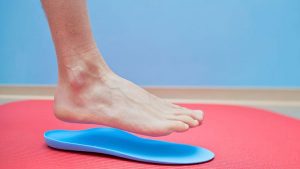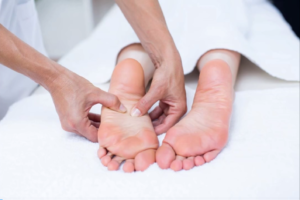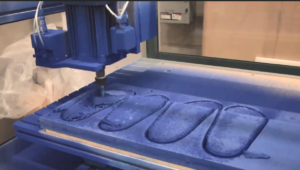I. Orthopedic insole
An orthopedic insole is a kind of bottom orthopedic aid, which can change the ground to acclimatize to the wearer’s particular bottom shape. Just as numerous people need to wear spectacles (technically called vision correction), people suffering from lower branch biomechanical abnormalities or bottom mechanical problems caused by these abnormalities need to wear a correction product-orthopedic bottom insoles.
II. the function of orthopedic insoles
1. Effect on bottom pain, lower reverse and leg pain Bottom and ankle croakers have verified by exploration that the habitual injury of lower branch bones and joints is substantially due to the biomechanics of the lower branches. It can also be said that the lower branches natural force line ( negative graveness line) has changed., Performing in abnormal stress on bones and joints. Wearing orthopedic insoles corrected the valgus disfigurement of the bottom and the deformation of the ankle joint during walking, bettered the cargo-bearing line of the lower branches to varying degrees, and also bettered the unstable force of the ankle and knee joints, thereby reducing the ankle and knee joints. Habitual damage to the joints, thereby easing or relieving symptoms similar to backaches and backaches.
2. Effect on flat bases In children with natural flat bases, start to wear orthopedic insoles at an early stage, which can’t only help the circumstance of flat bases complications, correct the children’s bad gait, and reshape normal bases bow. For adult flat bases, orthopedic insoles can scientifically support the bow of the bottom and effectively relieve the symptoms of bottom fatigue, pain and discomfort, and shin muscle soreness caused by flat bases.
3. Effect on heel pain We know that heel pain substantially occurs in women over 40 times old, and the most common clinical cause is”plantar fasciitis.”After wearing orthopedic insoles, relieves the pressure of the plantar fascia and reduces the strain of the plantar fascia. The heel part of the healthy insoles has a mesh structure, which can relieve the pressure on the heel and reduce the pain. Long-term wearing can achieve relief or relief. The purpose of the symptoms.

4. Effect on plantar calluses (calluses) or forefoot pain Plantar calluses (calluses) substantially do under the alternate and third metatarsal heads. It’s caused by the collapse of the alternate and third metatarsal heads, which increases original stress. Locally caused by squeezing and disunion. After wearing the orthopedic insole, the force on the sole of the bottom is redistributed, and the concentrated force under the alternate and third metatarsal heads is reduced. The forefoot has a mesh structure, which can well relieve the pressure on the forefoot. It relieves the painful symptoms of the footpad, and long-term use can fully exclude the plantar calluses (calluses).
5. Effect on hallux valgus and bunion In addition to heredity, hallux valgus is substantially caused by wearing high-top-point shoes. Wear orthopedic insoles. The shoes have a wide circumference to help the sharp and narrow shoes from squeezing the big toe of the bottom, reduce pain, help aggravation and complications, and help hallux valgus and bunions.
6. It also has a good relieving effect on habitual ankle sprains and habitual pain left after ankle sprains. This is because after wearing orthopedic insoles, the strength of the muscles and ligaments on both sides of the ankle joint is balanced, and the ankle joint is corrected. The cock of the face increases the stability of the ankle joint and improves the the-parallel force of the ankle joint. Thus, it plays a good part in easing the pain of the ankle joint and precluding ankle common sprains.
III. what’s a good orthopedic insole
(1) Function
1. Arch support
The main function of the bow of the bottom is to disperse graveness from the ankle joint through the talus to the metatarsal head and back to the calcaneus to ensure the stability of the plantar support when standing upright.
When walking, especially when traveling for long distances, the pliantness of the bottom bow has a softening effect on the meter between the body’s downcast transmission of graveness and the ground rebound force, and it also has the effect of keeping the blood vessels and jitters of the soles from being compressed. Orthopedic insoles can scientifically support the bow of the bottom and effectively relieve the symptoms of bottom fatigue, pain and discomfort, and shin muscle soreness caused by flat bases.
2. Stable heel
In the design of orthopedic insoles, the height of the heel mug is frequently increased to achieve the function of belting the heel and stabilizing the heel. The heel bottom is one of the three-point force support points, which is particularly important. It works together with the bow support module to give bottom protection, The part of stability.
( 2) Comfort
Everyone has different rigidity. Different people will have different passions when wearing the same insole. For people with flexible bottom joints, acceptable support can ameliorate the stability of the bases and help cases more correct their bodies. The line of force achieves the purpose of correction, and for cases with stiff bases, we need to acclimate the angle meetly to achieve the angle we need to correct to a certain extent and a balance that’s comfortable for the case. This requires that the front-end evaluation must be accurate, and give substantiated characteristic design and product
(3) Appearance
In terms of appearance, there are a wide variety of orthopedic insoles on the request, which can not be attracted by the various colors. Further attention should be paid to the function of orthopedic insoles. A good orthopedic insole doesn’t inescapably have a good appearance, so it’s suitable for you. Is stylish.
(4) Cost-effective
In addition to meeting the needs of patients, a good insole has a price that is close to the people, which means that it is suitable for choosing finished insoles for mild cases. Patients with complex diseases can choose personalized customization, and purchase insoles that suit them according to their situation

(5) Choose insoles
There are many types of insoles on the market, such as those purchased online, plaster-based, patch-based, custom-made 3D engraving/printing, and thermoplastic. The choice of type needs to be based on the patient’s situation, such as flat feet, which is simply required. Adequate arch support can be significantly improved, and there is no need to deliberately pursue personalized custom insoles.
(6) Material of insole
To ensure the functionality, comfort, and durability of the insole, there are sufficient requirements for the material of the insole, and the performance of domestically-made materials needs to be further improved. The development and research of imported plates from foreign countries for many years have been approaching perfection.
Hot blogs:
The Easiest Custom Insoles: Heat Moldable Insoles
Custom insoles, also known as orthotic insoles, are designed to provide personalized support and comfort for individuals with various foot conditions. In [...]
Children’s Insole Size Conversion Chart
The standard sizes for shoe insoles may vary from country to country, making it a headache to choose the right insole for [...]
Do custom orthotics need to be made by a doctor personally?
Custom orthotics do not necessarily need to be made by a doctor personally. While doctors, specifically podiatrists or orthopedic specialists, are often [...]
Do NBA players use custom insoles?
Custom insoles are not only helpful for people with foot health issues, but they also play a significant role in targeting the [...]

